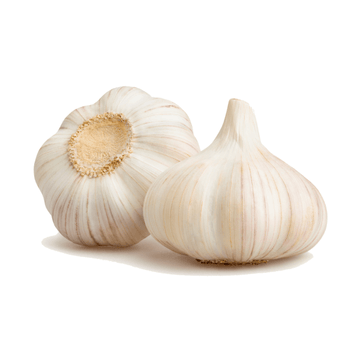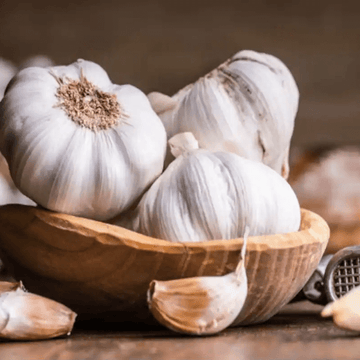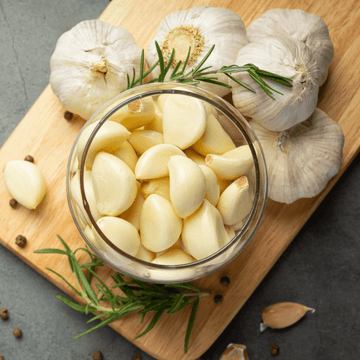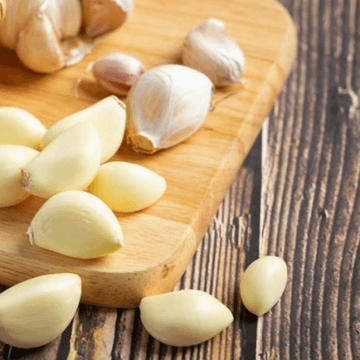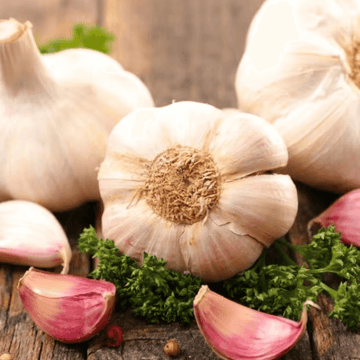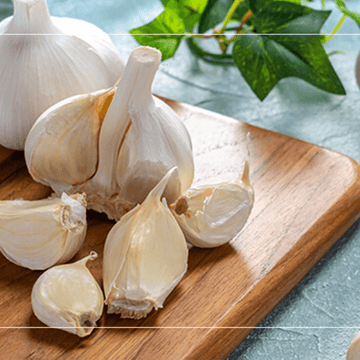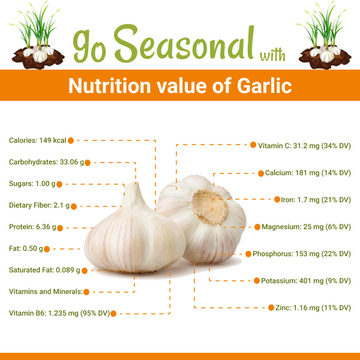
4.8/5
Based on 10,000+Happy Customers
Buy Garlic - China( لہسن ) - 1kg
Best Offers: 1kg
Quantity:

Cash On Delivery
Easy Return & Refund Policy
24/7 Customer Support
Garlic (Allium sativum) is one of the oldest cultivated plants in the world. Its origins trace back over 5,000 years to Central Asia, specifically around the regions of modern-day Iran and Turkmenistan. It spread quickly through the ancient civilizations of Mesopotamia, Egypt, and the Indus Valley. Garlic was highly valued by the Egyptians, Greeks, Romans, and Chinese, both for its culinary uses and its medicinal properties. The Egyptians believed garlic gave strength and endurance, which is why it was fed to slaves building the pyramids. In ancient Greek and Roman times, garlic was used to treat various health conditions, including respiratory issues, poor digestion, and low energy
Garlic (Allium sativum) is one of the oldest cultivated plants in the world. Its origins trace back over 5,000 years to Central Asia, specifically around the regions of modern-day Iran and Turkmenistan. It spread quickly through the ancient civilizations of Mesopotamia, Egypt, and the Indus Valley. Garlic was highly valued by the Egyptians, Greeks, Romans, and Chinese, both for its culinary uses and its medicinal properties. The Egyptians believed garlic gave strength and endurance, which is why it was fed to slaves building the pyramids. In ancient Greek and Roman times, garlic was used to treat various health conditions, including respiratory issues, poor digestion, and low energy...
Benefits
-
Reduces Blood Pressure: Studies have shown that garlic supplementation can have a significant impact on reducing high blood pressure, particularly in individuals with hypertension.
-
Improves Cholesterol Levels: Garlic can lower total and LDL cholesterol, which can help reduce the risk of heart disease.
-
Antioxidant Properties: Garlic contains antioxidants that support the body’s protective mechanisms against oxidative damage, which can help prevent diseases like Alzheimer's and dementia.
-
Anti-Inflammatory Effects: The sulfur compounds in garlic have anti-inflammatory properties, which can help in reducing inflammation in the body.
-
Detoxification: Garlic has been found to help detoxify heavy metals in the body, particularly lead, by enhancing the production of detoxifying enzymes.
Uses of Garlic
-
Culinary Uses: Garlic is a staple in many cuisines around the world. It is used to flavor dishes such as sauces, soups, marinades, and stews. It can be used fresh, powdered, or as garlic oil.
-
Medicinal Uses: Garlic supplements and extracts are used to treat various health conditions. It is available in several forms, including capsules, tablets, and oils.
-
Traditional Medicine: In traditional medicine, garlic has been used to treat a wide range of conditions, including infections, digestive problems, and respiratory issues.
-
Topical Applications: Garlic is sometimes applied topically to treat fungal infections, warts, and skin conditions due to its antimicrobial properties.
Nutritional Value of Garlic (per 100 grams)
-
Calories: 149 kcal
-
Carbohydrates: 33.06 g
-
Sugars: 1.00 g
-
Dietary Fiber: 2.1 g
-
Protein: 6.36 g
-
Fat: 0.50 g
-
Saturated Fat: 0.089 g
-
Vitamins and Minerals:
-
Vitamin B6: 1.235 mg (95% DV)
-
Vitamin C: 31.2 mg (34% DV)
-
Calcium: 181 mg (14% DV)
-
Iron: 1.7 mg (21% DV)
-
Magnesium: 25 mg (6% DV)
-
Phosphorus: 153 mg (22% DV)
-
Potassium: 401 mg (9% DV)
-
Zinc: 1.16 mg (11% DV)
Main is lehsan se poori tarah se mutmain hoon aur ise highly recommend karti hoon. Aage bhi main yahin se khareedunge. Shukriya aapki excellent service ke liye
I’m very satisfied with this garlic and highly recommend it. I’ll definitely buy it again. Thanks for the excellent service!
I recently bought garlic from mirchu, and I’m really happy with it. The garlic is fresh, firm, and has a strong smell, which shows it's high quality.
Main is product ki quality se poori tarah se mutmain hoon aur main is lehsan ko highly recommend karti hoon. Aage bhi zaroor yahin se khareedunga. Shukriya aapki excellent service ke liye!
Mujhe packaging bhi achi lagi, jo lehsan ko puri tarah se fresh rakhti hai. Yeh bhi achi baat hai ke lehsan health ke liye bhi faidemand hai, jaise ke immunity barhane aur digestion mein madad karne ke liye. Main is quality se bohot mutmain hoon aur aage bhi aap se khareedunga. Shukriya!





Milk is a versatile and nutrient-rich beverage that has been consumed by humans for thousands of years. Derived primarily from cows, but also from goats, sheep, and other mammals, milk is renowned for its creamy...





The date palm is dioecious, having separate male and female plants. They can be easily grown from seed, but only 50% of seedlings will be female and hence fruit-bearing, and plant dates are often smaller...





The date palm is dioecious, having separate male and female plants. They can be easily grown from seed, but only 50% of seedlings will be female and hence fruit-bearing, and plant dates are often smaller...





Bananas are among the most important food crops on the planet. They come from a family of plants called Musa that are native to Southeast Asia and grown in many of the warmer areas of...





Pomegranates (Punica granatum) have a storied history dating back millennia, originating in regions of modern-day Iran and spreading throughout ancient civilizations. Revered in mythology and religious texts for symbolizing fertility and abundance, pomegranates were buried...





Pomegranates (Punica granatum) have a storied history dating back millennia, originating in regions of modern-day Iran and spreading throughout ancient civilizations. Revered in mythology and religious texts for symbolizing fertility and abundance, pomegranates were buried...





The blood orange is a natural mutation of the orange, which is itself a hybrid, probably between the pomelo and the tangerine. Within Europe, the arancia rossa di Sicilia (red-orange of Sicily) has Protected Geographical...





Musami, also known as sweet lime or mosambi, is believed to have originated in Southeast Asia, particularly in India. It is a citrus fruit, and its cultivation spread to various tropical and subtropical regions due...





The apple is thought to have been domesticated 4,000–10,000 years ago in the Tian Shan mountains, and then to have travelled along the Silk Road to Europe, with hybridization and introgression of wild crabapples from...





Ambri is the only variety indigenous to our subcontinent. It grows in Kashmir and is one of its most closely guarded secrets... The apple is thought to have been domesticated 4,000–10,000 years ago in the Tian...





The apple is thought to have been domesticated 4,000–10,000 years ago in the Tian Shan mountains, and then to have travelled along the Silk Road to Europe, with hybridization and introgression of wild crabapples from...





The apple is thought to have been domesticated 4,000–10,000 years ago in the Tian Shan mountains, and then to have travelled along the Silk Road to Europe, with hybridization and introgression of wild crabapples from...





The avocado, alligator pear, or avocado pear (Persea americana) is a medium-sized, evergreen tree in the laurel family (Lauraceae). It is native to the Americas and was first domesticated in Mesoamerica more than 5,000 years...





Elizabeth White: The Woman Who Invented the Blueberry | New Jersey: Then and Now. By 1916, Elizabeth White and Dr. Fredrerick Coville, USDA Botanist, had cultivated the first batch of domesticated blueberries. This clip explains...





A pitaya (/pɪˈtaɪ.ə/) or pitahaya (/ˌpɪtəˈhaɪ.ə/) is the fruit of several different cactus species indigenous to the region of southern Mexico and along the Pacific coasts of Costa Rica, El Salvador, Guatemala and Nicaragua. Pitaya...





Cabbage is one of the oldest cultivated vegetables, with origins dating back over 2,000 years. It is believed to have been grown in ancient civilizations such as the Greeks and Romans. The earliest records of...





The Middle East is generally described as the homeland of grapes and the cultivation of this plant began there 6,000–8,000 years ago. Yeast, one of the earliest domesticated microorganisms, occurs naturally on the skins of...





Turnips (Brassica rapa) have a long history that dates back thousands of years. They were first cultivated in the Mediterranean region, and evidence suggests they were being grown by the Greeks and Romans around 2000...





The blackberry is an edible fruit produced by many species in the genus Rubus in the family Rosaceae, hybrids among these species within the subgenus Rubus, and hybrids between the subgenera Rubus and Idaeobatus. The...





The first garden strawberry was grown in Brittany, France, during the late 18th century. Before this, wild strawberries and cultivated selections from wild strawberry species were the common source of the fruit. The strawberry fruit...





Shakarkandi, commonly known as sugarcane Saccharum officinarum, is a tall, perennial grass native to Southeast Asia and the South Pacific. It has been cultivated for thousands of years, with evidence of its use dating back...





Guavas originated from an area thought to extend from Mexico, Central America or northern South America throughout the Caribbean region. Archaeological sites in Peru yielded evidence of guava cultivation as early as 2500 BC... Guava...





Beetroot, also known as beet, has a long and storied history. It is believed to have originated in the Mediterranean region and was initially cultivated for its leaves rather than its roots. Ancient civilizations such...





Grapes are a type of fruit that grows in clusters of 15 to 300 and can be crimson, black, dark blue, yellow, green, orange, and pink. "White" grapes are green in color and are evolutionarily...





Peas (Pisum sativum) have been cultivated for thousands of years and are among the earliest domesticated crops. Evidence suggests that peas were grown in the Middle East as early as 7000-8000 BCE. They were an...





Grapes are a type of fruit that grows in clusters of 15 to 300 and can be crimson, black, dark blue, yellow, green, orange, and pink. "White" grapes are green in color and are evolutionarily...





Cauliflower has a long history that dates back to ancient times. It is believed to have originated in the Mediterranean region, where it was cultivated by the Romans and Greeks. It was known in the...





Radishes (Raphanus sativus) have been cultivated for thousands of years. They are believed to have originated in Southeast Asia, with evidence of their cultivation dating back to ancient Egypt and Greece. The Greeks and Romans...





Carrots have a long history dating back over 5,000 years. Originally cultivated in Persia (modern-day Iran and Afghanistan), they were first used for their leaves and seeds rather than their roots. The first cultivated carrots...





Spinach is a leafy green vegetable that has been cultivated for thousands of years. It is believed to have originated in Persia (modern-day Iran) and was first cultivated in ancient Persia and Mesopotamia. Spinach was...





The pumpkin (Cucurbita pepo) has a history that stretches back thousands of years. Native to North America, pumpkins were cultivated by Indigenous peoples as early as 7,500 to 5,000 BC. Early Native American tribes used...





Karela- also known as Bitter Gourd and Momordica Charantia. It is a vine plant that gives a nutritional green vegetable.It is a healthy vegetable in the world that has been used in many health problems...





Chickens are relatively large birds, active by day. The body is round, the legs are unfeathered in most breeds, and the wings are short. Wild junglefowl can fly; chickens and their flight muscles are too...





Chickens are relatively large birds, active by day. The body is round, the legs are unfeathered in most breeds, and the wings are short. Wild junglefowl can fly; chickens and their flight muscles are too...





Chickens are relatively large birds, active by day. The body is round, the legs are unfeathered in most breeds, and the wings are short. Wild junglefowl can fly; chickens and their flight muscles are too...





Chickens are relatively large birds, active by day. The body is round, the legs are unfeathered in most breeds, and the wings are short. Wild junglefowl can fly; chickens and their flight muscles are too...





Capsicum, commonly known as bell pepper, has a long and fascinating history. Native to the Americas, it was cultivated by indigenous peoples long before the arrival of Europeans. Christopher Columbus encountered capsicum during his voyages...





Ginger (Zingiber officinale) is a flowering plant whose rhizome, ginger root, or ginger, is widely used as a spice and a folk medicine. It is believed to have originated in the tropical rainforests of the...





Garlic (Allium sativum) is one of the oldest cultivated plants in the world. Its origins trace back over 5,000 years to Central Asia, specifically around the regions of modern-day Iran and Turkmenistan. It spread quickly...





Chili peppers are believed to have been first cultivated by the ancient civilizations in Central and South America, including the Aztecs, Incas, and Mayans, as early as 7,000 BCE. Christopher Columbus encountered chili peppers in...








































































































